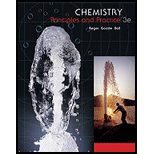
Concept explainers
(a)
Interpretation:
The species, which have stronger bonds between,
Concept Introduction:
Bond energy:
The bond order is the number of electrons pairs shared between two atoms in the formation of the bond. The amount of energy required to break a bond is called
Bond order
Where,
(a)
Answer to Problem 10.93QE
The bond in
Explanation of Solution
The molecular electronic configuration of boron molecule is,
The number of electrons in the bonding orbital=6
The number of electrons in the antibonding orbital=4
The bond order of boron molecule can be calculated as,
Bond order
The molecular electronic configurations of
The number of electrons in the bonding orbital is five.
The number of electrons in the antibonding orbital is four.
Bond order of
Bond order
The bond order of
(b)
Interpretation:
The species, which have stronger bonds between,
Concept Introduction:
Refer to part (a).
(b)
Answer to Problem 10.93QE
The bond in
Explanation of Solution
The molecular electronic configuration of
Bond order of
Bond order
There are six electrons in bonding and four electrons in antibonding orbitals.
The molecular electronic configuration of
The number of electrons in the bonding orbital is five and the number of electrons in antibonding orbital is 4.
Bond order
The bond order of the
(c)
Interpretation:
The species that have stronger bonds between
Concept Introduction:
Refer to part (a).
(c)
Answer to Problem 10.93QE
The bond in
Explanation of Solution
The molecular configuration of
There are ten electrons in bonding orbital and six electrons antibonding orbitals.
Bond order of
The molecular configuration of
Bond order of
Bond order of
The bond order of the
Want to see more full solutions like this?
Chapter 10 Solutions
Chemistry
- What are the number of pi and sigma bonds in NO2-1?arrow_forward(a) Methane (CH4) and the perchlorate ion (ClO4- ) are bothdescribed as tetrahedral. What does this indicate about theirbond angles? (b) The NH3 molecule is trigonal pyramidal, while BF3 is trigonal planar. Which of these molecules is flat?arrow_forwardA.) What is the electron geometry of IF5? B.) What is the molecular geometry of IF5? C.) Ignoring lone-pair effects, what is the smallest bond angle in IF5?arrow_forward
- Provide Lewis structures, electronic pair geometry and hybridization atoms marked in bold in the following molecules: A. H2CCCH2 B. Cl O 3 c. N O 3 d. O C Cl 2arrow_forwardShown below is the molecular orbital diagram for N2. Does N2+ have a shorter or longer bond length?arrow_forwardWhich of the following is most stable according to its molecular orbital diagram? F2+2, O2+2, F2-2, Ne2+2, F2arrow_forward
- Consider the molecular structure for linuron, an herbicide, provided in the questions below. Which hybrid orbitals overlap to form the sigma bond between oxygen-1 and nitrogen-2?arrow_forwardWhich of the following is trigonal planar? a. boron trifluoride, BF3 b. methyl anion, CH3− c. methane, CH4 d. ammonia, NH3 Group of answer choices a b c darrow_forwardA student claims that if element D is in group 18, then the molecular geometry of DF4(g) is square planar. Do you agree or disagree with the student? Justify your answer in terms of the VSEPR theory.arrow_forward
 Chemistry: Principles and PracticeChemistryISBN:9780534420123Author:Daniel L. Reger, Scott R. Goode, David W. Ball, Edward MercerPublisher:Cengage Learning
Chemistry: Principles and PracticeChemistryISBN:9780534420123Author:Daniel L. Reger, Scott R. Goode, David W. Ball, Edward MercerPublisher:Cengage Learning Chemistry: The Molecular ScienceChemistryISBN:9781285199047Author:John W. Moore, Conrad L. StanitskiPublisher:Cengage Learning
Chemistry: The Molecular ScienceChemistryISBN:9781285199047Author:John W. Moore, Conrad L. StanitskiPublisher:Cengage Learning

